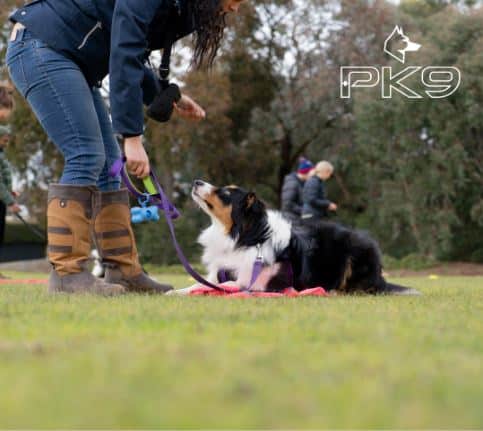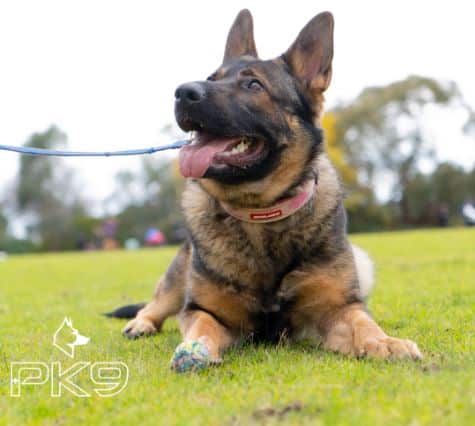Imagine transforming your dog’s behaviour through a training method rooted in scientific principles, fostering a stronger bond between you and your furry companion while reducing stress and anxiety. The power of positive reinforcement in dog training can achieve just that. This blog post will guide you through the ins and outs of positive reinforcement, its benefits, and how to implement it in your dog’s training regimen successfully.
Short Summary
- Positive reinforcement is a scientifically-based training method for dogs that utilises reward-based methods such as treats, praise and clicker training.
- Benefits of this approach include improved behaviour, strengthened relationships between owner & dog, and reduced stress & anxiety.
- Case studies have demonstrated the effectiveness of positive reinforcement in successful dog training with all ages/stages of life.
Understanding Positive Reinforcement in Dog Training
Positive reinforcement is a widely used training method in the dog world, based on scientific principles, that involves rewarding desired behaviours to make them more likely to be repeated. Many dog owners have found success with this approach as it encourages dogs to learn and perform desired behaviours willingly. Reward-based training, a component of positive reinforcement, sets the dog up for success by rewarding them for exhibiting the desired behaviour. Clicker training, a popular method within positive reinforcement, uses a distinct noise to mark a moment and indicate that a reward is imminent, making the training more effective. Maintaining accurate timing and consistency in clicker training is essential, as the click must closely follow the desired behaviour, and each click must be accompanied by a reward.
The science behind positive reinforcement is rooted in B.F. Skinner’s operant conditioning model, has become a foundation for how dogs are trained today. In operant conditioning, behaviours are regulated by studying their consequences, such as rewards or punishments. This principle is used to train dogs effectively, reinforcing desired behaviours and suppressing undesired ones through the strategic use of rewards and punishments.
The Science Behind Positive Reinforcement
Operant conditioning, first described by Edward L. Thorndike in the early 1900s, is a key component of positive reinforcement training. Thorndike’s “law of effect” states that behaviours followed by pleasant or desirable outcomes are more likely to be repeated, while those followed by undesirable outcomes are less likely to be repeated. Skinner’s model of operant conditioning outlines four techniques for conditioning behaviour to teach, train, and manage it, which can be helpful for dog owners. By employing operant conditioning, dog trainers can facilitate teaching, training, and behaviour management in dogs, reinforcing desired behaviours and suppressing undesired ones using negative punishment. This process can contribute to the development of a strong bond between the dog and its owner.
Reward-based training methods, a component of positive reinforcement, can include treats, praise, toys, and playtime, which can be employed to incentivise desired behaviours in dogs. Rewards can come in many forms, such as a food treat, a favourite chew toy or verbal praise like “good dog!” These rewards are a great way to show your pet that they have done something good.” delivered in a pleasant tone of voice. Clicker training is one such reward-based method, often used by balanced dog trainers, that utilises a clicker (or marker) to make training more effective. Clicker training involves conditioning a clicker to become a reinforcer by repeatedly associating it with a reward or treat, thereby making positive reinforcement training more efficient.
Reward-Based Training Methods
One of the main advantages of reward-based training methods is their ability to encourage desired behaviours in dogs without resorting to physical punishment or forceful techniques. From tasty treats to enthusiastic praise, these methods provide positive reinforcement that helps dogs learn new skills and improve their behaviour over time. With a variety of reward options available, it’s essential to find the right incentives that will motivate your dog and make learning enjoyable for both of you.
Clicker training, a popular reward-based method, is an excellent example of how positive reinforcement can be both effective and enjoyable for dogs and their owners. By utilising a clicker to mark and reward desired behaviours accurately, dogs quickly learn to associate the clicking sound with a positive outcome, such as a treat or praise. This clear, consistent feedback helps dogs understand what behaviour is being rewarded, making the learning process more efficient and enjoyable for both dog and owner.
Comparing Positive Reinforcement to Other Training Methods

In addition to positive reinforcement, there are other dog training methods available for dogs, such as balanced dog training, purely positive training, and negative reinforcement and punishment. Each method has its own set of advantages and disadvantages, and it’s essential to understand the differences between them in order to choose the most effective approach for your dog.
In this section, we’ll compare positive reinforcement to these other methods and explore their impact on canine behaviour and the owner-dog relationship.
Balanced Dog Training
Balanced dog training combines all elements of operant conditioning. Balanced trainers often use various tools with their canine students. The role of pressure in balanced dog training is to provide a means of communication with the dog and to disrupt its thought process. The most noteworthy outcome of balanced training is the trust established between the dog and its handler.
However, there have been accusations of abuse and the belief that positive-only training is the only humane way to train a dog, presented as arguments against balanced dog training. It’s crucial to consider the potential consequences of using aversive methods and to weigh them against the benefits of positive reinforcement when deciding on the best approach for your dog.
Purely Positive Training
Purely positive training, on the other hand, focuses exclusively on rewarding good behaviour and ignoring undesired behaviour. This approach is based on the Least Intrusive, Minimally Aversive (LIMA) training principle, which seeks to achieve training objectives with minimal risk of producing aversive side effects. LIMA training employs ethical and humane methodologies supported by scientific evidence and consistently aims to use techniques that do not cause pain, surprise reactions, or excessive stress.
In the event that a dog displays signs of discomfort during training, a LIMA trainer should reassess the training scenario and adjust the bridging signal to ensure the dog remains an eager participant. This approach can lead to a more enjoyable and stress-free training experience for both the dog and the owner, fostering a stronger bond and improved behaviour over time.
Negative Reinforcement and Punishment
Negative reinforcement and punishment involve discouraging undesired behaviours through aversive stimuli. While these methods can be effective in some situations, they can also lead to increased anxiety, aggression, and fearfulness in dogs. It is essential to ensure that the negative stimulus is not too intense and is only utilised for a limited period when employing negative reinforcement. Furthermore, it is crucial to implement positive reinforcement when the desired behaviour is exhibited.
By understanding the potential risks associated with negative reinforcement and punishment, dog owners can make more informed decisions about the most appropriate training methods for their dogs. With a focus on rewards and praise rather than punishment and aversive stimuli, positive reinforcement offers a more effective and humane approach to dog training.
Implementing Positive Reinforcement in Your Dog's Training

Choosing the Right Rewards

Selecting the appropriate rewards for your dog is a crucial aspect of positive reinforcement training. Every dog is unique, and their preferences for rewards can vary greatly. Some dogs may be motivated by food treats, while others may prefer praise, toys, or playtime.
It’s essential to experiment with different types of rewards to determine what works best for your dog and to ensure that the rewards you choose will effectively reinforce the desired behaviour.
Timing & Consistency
Timing and consistency are essential components of successful, positive reinforcement training. Providing a reward soon after the desired behaviour is performed increases the likelihood of the behaviour being repeated. Accurate timing bolsters the connection between the behaviour and the reward, resulting in more successful training results.
Consistency in using the same signals and instructions helps dogs understand what is being asked of them and makes the learning process smoother and more efficient.
Clicker Training: A Powerful Tool for Positive Reinforcement
Clicker training is a powerful tool for positive reinforcement, using a mechanical noisemaker to mark and reward good behaviour, helping dogs understand what behaviour is being rewarded. It operates by conditioning a clicker to become a reinforcer by repeatedly associating it with a reward or treat, thereby making positive reinforcement training more efficient. Clicker training can facilitate better canine behaviour, foster a stronger relationship between pet and guardian, and alleviate stress and tension.
In order to successfully implement clicker training, it is essential to select appropriate rewards, such as treats or toys, and to be consistent with timing. Additionally, patience and consistency are vital to ensuring that the dog understands the clicker and the rewards. With practice and dedication, clicker training can lead to noticeable improvements in your dog’s behaviour and strengthen the bond between you and your furry friend.
Benefits of Positive Reinforcement for Dogs and Owners

By now, you’ve seen that positive reinforcement offers numerous benefits for both dogs and their owners. Not only does it lead to improved dog behaviour, but it also strengthens the owner-dog relationship and reduces stress and anxiety.
Let’s take a closer look at these benefits and how they can positively impact your life and your dog’s well-being.
Improved Dog Behaviour
Positive reinforcement leads to improved dog behaviour by encouraging desired behaviours and discouraging undesired ones. By rewarding good behaviour and withholding rewards for undesirable behaviour, dogs learn which actions are desired and are more likely to repeat them in the future. This can result in a well-behaved dog that is more obedient, attentive, and responsive to commands.
In addition, positive reinforcement can help address and modify unwanted behaviours in dogs. For example, if a dog tends to jump on guests, positive reinforcement can be used to teach the dog to sit calmly instead. By rewarding desired behaviour (sitting) and withholding rewards for undesirable behaviour (jumping), the dog learns which actions are more likely to result in a positive outcome, ultimately leading to improved behaviour over time.
Strong Owner-Dog Relationship
Using positive reinforcement not only enhances your dog’s behaviour but also strengthens the bond between you and your canine companion. This training approach fosters trust, communication, and mutual understanding between you and your dog. By consistently rewarding desired behaviours and providing clear feedback, your dog learns to trust and respect your commands, nurturing mutual respect and a stronger relationship.
Moreover, a positive training experience can lead to a happier and more content dog, as they feel a sense of accomplishment and satisfaction when they receive rewards for good behaviour. This sense of security and comfort can help reduce stress and anxiety in your dog, further enhancing the bond between you and your furry friend.
Reduced Stress and Anxiety
Focusing on rewards and praise rather than punishment and aversive stimuli, positive reinforcement reduces stress and anxiety in dogs. This approach provides dogs with a sense of security and comfort, helping them feel more relaxed and at ease in their environment.
By creating a positive and enjoyable training experience, positive reinforcement can contribute to happier, healthier, and more well-adjusted dogs trained in this method.
Challenges and Misconceptions About Positive Reinforcement
Despite the proven effectiveness of positive reinforcement, there are still challenges and misconceptions that need to be addressed. Some dog owners may be resistant to change, or there may be myths circulating about the effectiveness and application of positive reinforcement.
In this section, we will discuss how to overcome these challenges and debunk common misconceptions to help ensure the success of your dog’s training journey.
Overcoming Resistance to Change
Overcoming resistance to change in dog training involves educating dog owners about the benefits of positive reinforcement and addressing concerns about traditional training methods. It’s important to highlight the advantages of using positive reinforcement, such as improved canine behaviour, a stronger bond between the owner and dog, and a decrease in stress and anxiety.
By addressing the drawbacks of traditional training methods in the dog training world, such as their severity and potential to cause confusion and frustration for both dog and owner, a skilled dog trainer can help dog owners understand the value of adopting a positive reinforcement approach.
Debunking Myths About Positive Reinforcement
One common misconception about positive reinforcement is that it is only applicable for basic commands and not successful in addressing more complex behaviours. However, positive reinforcement can be used to shape behaviours in dogs of all ages, from simple commands to more complicated behaviours. Another myth is that positive reinforcement is exclusively utilised for puppies, which is simply not true. This training method can be effective for dogs of all ages and stages of life.
Another misconception is that positive reinforcement relies solely on the use of treats, leading some to believe that their dog will become dependent on treats for good behaviour. In reality, treats are just one of many rewards that can be used in positive reinforcement training, and they should not serve as a replacement for other forms of reinforcement, such as verbal praise or play. By debunking these myths and misconceptions, we can help dog owners make informed decisions about their dog’s training and ensure the success of positive reinforcement in their dog’s life.
Summary
In conclusion, positive reinforcement is a powerful and effective method for training dogs, rooted in scientific principles and offering numerous benefits for both dogs and their owners. By understanding the science behind positive reinforcement, comparing it to other training methods, and learning how to implement it in your dog’s training successfully, you can transform your dog’s behaviour, strengthen your bond, and create a happier, healthier environment for you and your furry friend. So why not embrace the power of positive reinforcement and embark on a rewarding training journey with your canine companion?
Frequently Asked Questions
Positive reinforcement can come in the form of natural, tangible, social, and token rewards, all of which can be delivered as part of a partially fixed schedule in experiments.
Positive reinforcement has been proven to be an effective tool for reinforcing desirable behaviours and improving social skills, with long-lasting effects even after the reward system is discontinued (Diedrich, 2010).
It has been used in a variety of settings, including classrooms, workplaces, and even in the home. It is a powerful tool for encouraging positive behaviour and can be used to shape behaviour in a variety of ways.
For example, positive reinforcement can be used to reward positive reinforcement.
Positive reinforcement is a form of behaviour manipulation and is considered the cornerstone of Applied behaviour Analysis. Therefore, it can be said that positive reinforcement is a type of manipulation.
Balanced Dog Training is a combination of reward-based techniques and the use of aversive consequences to help modify a dog’s behaviour. It emphasises that choices and behaviours have both positive and negative results.
Rewards are used to encourage desirable behaviours, while aversive consequences are used to discourage undesirable behaviours. This approach is based on the idea that dogs should be taught to make the right choices rather than simply being punished for doing so.



